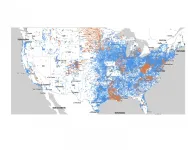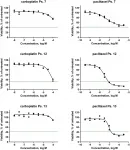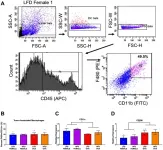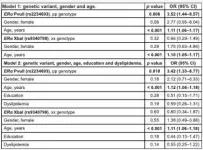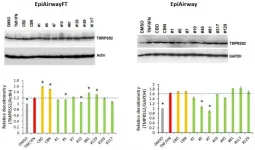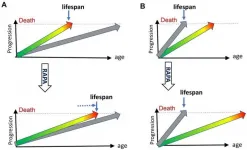(Press-News.org) The perils of machine learning - using computers to identify and analyze data patterns, such as in facial recognition software - have made headlines lately. Yet the technology also holds promise to help enforce federal regulations, including those related to the environment, in a fair, transparent way, according to a new study by Stanford researchers.
The analysis, published this week in the proceedings of the Association of Computing Machinery Conference on Fairness, Accountability and Transparency(link is external), evaluates machine learning techniques designed to support a U.S. Environmental Protection Agency (EPA) initiative to reduce severe violations of the Clean Water Act. It reveals how two key elements of so-called algorithmic design influence which communities are targeted for compliance efforts and, consequently, who bears the burden of pollution violations. The analysis - funded through the Stanford Woods Institute for the Environment's Realizing Environmental Innovation Program - is timely given recent executive actions(link is external) calling for renewed focus on environmental justice.
"Machine learning is being used to help manage an overwhelming number of things that federal agencies are tasked to do - as a way to help increase efficiency," said study co-principal investigator Daniel Ho, the William Benjamin Scott and Luna M. Scott Professor of Law at Stanford Law School. "Yet what we also show is that simply designing a machine learning-based system can have an additional benefit."
Pervasive noncompliance
The Clean Water Act aims to limit pollution from entities that discharge directly into waterways, but in any given year, nearly 30 percent of such facilities self-report persistent or severe violations of their permits. In an effort to halve this type of noncompliance by 2022, EPA has been exploring the use of machine learning to target compliance resources.
To test this approach, EPA reached out to the academic community. Among its chosen partners: Stanford's Regulation, Evaluation and Governance Lab (RegLab), an interdisciplinary team of legal experts, data scientists, social scientists and engineers that Ho heads. The group has done ongoing work with federal and state agencies to aid environmental compliance.
In the new study, RegLab researchers examined how permits with similar functions, such as wastewater treatment plants, were classified by each state in ways that would affect their inclusion in the EPA national compliance initiative. Using machine learning models, they also sifted through hundreds of millions of observations - an impossible task with conventional approaches - from EPA databases on historical discharge volumes, compliance history and permit-level variables to predict the likelihood of future severe violations and the amount of pollution each facility would likely generate. They then evaluated demographic data, such as household income and minority population, for the areas where each model indicated the riskiest facilities were located.
Devil in the details
The team's algorithmic process helped surface two key ways that the design of the EPA compliance initiative could influence who receives resources. These differences centered on which types of permits were included or excluded, as well as how the goal itself was articulated.
In the process of figuring out how to achieve the compliance goal, the researchers first had to translate the overall objective into a series of concrete instructions - an algorithm - needed to fulfill it. As they were assessing which facilities to run predictions on, they noticed an important embedded decision. While the EPA initiative expands covered permits by at least sevenfold relative to prior efforts, it limits its scope to "individual permits," which cover a specific discharging entity, such as a single wastewater treatment plant. Left out are "general permits," intended to cover multiple dischargers engaged in similar activities and with similar types of effluent. A related complication: Most permitting and monitoring authority is vested in state environmental agencies. As a result, functionally similar facilities may be included or excluded from the federal initiative based on how states implement their pollution permitting process.
"The impact of this environmental federalism makes partnership with states critical to achieving these larger goals in an equitable way," said co-author Reid Whitaker, a RegLab affiliate and 2020 graduate of Stanford Law School now pursuing a PhD in the Jurisprudence and Social Policy Program at the University of California, Berkeley.
Second, the current EPA initiative focuses on reducing rates of noncompliance. While there are good reasons for this policy goal, the researchers' algorithmic design process made clear that favoring this over pollution discharges that exceed the permitted limit would have a powerful unintended effect. Namely, it would shift enforcement resources away from the most severe violators, which are more likely to be in densely populated minority communities, and toward smaller facilities in more rural, predominantly white communities, according to the researchers.
"Breaking down the big idea of the compliance initiative into smaller chunks that a computer could understand forced a conversation about making implicit decisions explicit," said study lead author Elinor Benami, a faculty affiliate at the RegLab and assistant professor of agricultural and applied economics at Virginia Tech. "Careful algorithmic design can help regulators transparently identify how objectives translate to implementation while using these techniques to address persistent capacity constraints."
INFORMATION:
Ho is also a professor of political science in Stanford's School of Humanities and Sciences, senior fellow at the Stanford Institute for Economic Policy Research (SIEPR), associate director of the Stanford Institute for Human-Centered Artificial Intelligence and faculty fellow at the Center for Advanced Study in the Behavioral Sciences. Co-authors of the study include Hongjin Lin, a research fellow at Stanford Law School; Brandon Anderson, head of data science in Stanford's RegLab; and Vincent La, a data scientist in Stanford's RegLab.
GAINESVILLE, Fla. --- Evolutionary arms races between marine animals overhauled ocean ecosystems on scales similar to the mass extinctions triggered by global disasters, a new study shows.
Scientists at Umeå University in Sweden and the Florida Museum of Natural History used paleontological databases to build a multilayered computer model of the history of marine life over the last 500 million years. Their analysis of the fossil record closely echoed a seminal 1981 study by paleontologist J. John Sepkoski - with one key difference.
Sepkoski's ground-breaking statistical work showed abrupt ocean-wide changes in biodiversity about 490 and 250 ...
Oncotarget published "Chemotherapy sensitivity testing on ovarian cancer cells isolated from malignant ascites" which reported that the authors aim is to determine the feasibility of cell proliferation assays of tumor cells isolated from malignant ascites to predict in vitro chemotherapy sensitivity, and to correlate these results with clinical outcome.
Cell samples were enriched for tumor cells and EOC origin was confirmed by intracellular staining of CK7, surface staining of CA125 and EpCAM, and HE4 gene expression.
In vitro sensitivity to chemotherapy was determined in cell proliferation assays using intracellular ATP content as an indirect measure of cell number.
In twelve of ...
Oncotarget published "High-fat diet-fed ovariectomized mice are susceptible to accelerated subcutaneous tumor growth potentially through adipose tissue inflammation, local insulin-like growth factor release, and tumor associated macrophages" which reported that the association between obesity and colorectal cancer (CRC) risk has been well established. This relationship appears to be more significant in men than in women, which may be attributable to sex hormones - controlled animal studies to substantiate these claims and the mechanisms involved are lacking. MC38 murine colon adenocarcinoma ...
Oncotarget recently published "Estrogen receptor α polymorphism is associated with dementia in a Brazilian cohort" which reported that the growth of the elderly population is a worldwide phenomenon and it is associated with chronic diseases, including dementia.
In this scenario, the present study aimed to evaluate a possible association of estrogen receptor α polymorphisms with dementia in a Brazilian cohort.
The genotyping for the ERα PvuII and XbaI polymorphisms were performed by polymerase chain reaction-restriction fragment length polymorphism.
The ERα PvuII pp genotype was associated with a higher odds ratio for dementia (OR = 3.42, 95% CI = 1.33-8.77, p = 0.01, ...
Here is a link to a free Altmetric Report on this Research Output
Aging-US published "Hyperbaric oxygen therapy increases telomere length and decreases immunosenescence in isolated blood cells: a prospective trial" which reported that the aim of the current study was to evaluate whether hyperbaric oxygen therapy (HBOT) affects telomere length (TL) and senescent cell concentrations in a normal, non-pathological, aging adult population.
Thirty-five healthy independently living adults, aged 64 and older, were enrolled to receive 60 daily HBOT exposures.
Whole blood samples were collected at baseline, at the 30th and 60th session, and 1-2 weeks following the last HBOT session.
Telomeres ...
Aging-US published "In search of preventive strategies: novel high-CBD Cannabis sativa extracts modulate ACE2 expression in COVID-19 gateway tissues" which reported that Cannabis sativa, especially those high in the anti-inflammatory cannabinoid cannabidiol, has been found to alter gene expression and inflammation and harbour anti-cancer and anti-inflammatory properties.
Working under a Health Canada research license, the Aging-US authors developed over 800 new C. sativa cultivars and hypothesized that high-CBD C. sativa extracts may be used to down-regulate ...
Aging-US published "DNA- and telomere-damage does not limit lifespan: evidence from rapamycin" which reported that failure of rapamycin to extend lifespan in DNA repair mutant and telomerase-knockout mice, while extending lifespan in normal mice, indicates that neither DNA damage nor telomere shortening limits normal lifespan or causes normal aging.
Dr. Mikhail V. Blagosklonny said, "As a provocative title has recently announced, 'rapamycin fails to extend lifespan in DNA repair -deficient mice' [1]. The word 'fails' implies bad news. Rapamycin tried but failed. Yet, it is expected that the anti-aging ...
East Hanover, NJ. March 8, 2021. Kessler Foundation researchers have demonstrated changes in the functional connectivity within the 'fatigue network' in response to cognitive fatigue. This finding, the first of its kind, was reported in Scientific Reports on December 14, 2020 in the open access article, "Using functional connectivity changes associated with cognitive fatigue to delineate a fatigue network" (doi: 10.1038//s41598-020-78768-3).
The authors are Glenn Wylie, DPhil, Brian Yao, PhD, Helen M. Genova, PhD, Michele H. Chen, PhD, and John DeLuca, PhD, of Kessler Foundation. All have faculty appointments at Rutgers New Jersey Medical School. Dr. Wylie is also a research scientist at The Department of Veterans' Affairs War-related Injury and Illness ...
A new study of the U.K. and South Africa variants of SARS-CoV-2 predicts that current vaccines and certain monoclonal antibodies may be less effective at neutralizing these variants and that the new variants raise the specter that reinfections could be more likely.
The study was published in Nature on March 8, 2021. A preprint of the study was first posted to BioRxiv on January 26, 2021.
David Ho (Credit: Columbia University Irving Medical Center)
The study's predictions are now being borne out with the first reported results of the Novavax vaccine, says the study's lead author David ...
Hamilton, ON (March 8, 2021) - An analysis of several large studies involving participants from more than 60 countries, spearheaded by researchers from McMaster University, has found that eating oily fish regularly can help prevent cardiovascular disease (CVD) in high-risk individuals, such as those who already have heart disease or stroke.
The critical ingredient is omega-3 fatty acids, which researchers found was associated with a lower risk of major CVD events such as heart attacks and strokes by about a sixth in high-risk people who ate two servings of fish rich in omega-3 each week.
"There is a significant protective benefit of fish consumption in people with cardiovascular disease," said lead co-author Andrew Mente, associate ...
